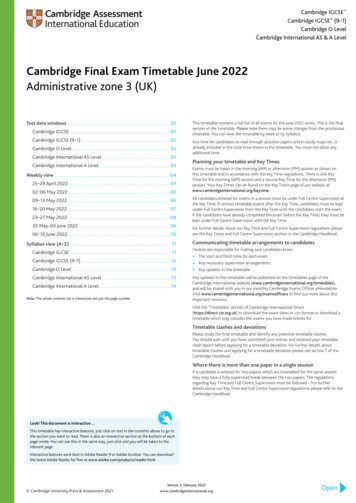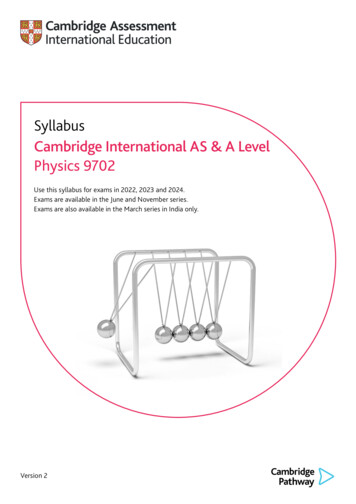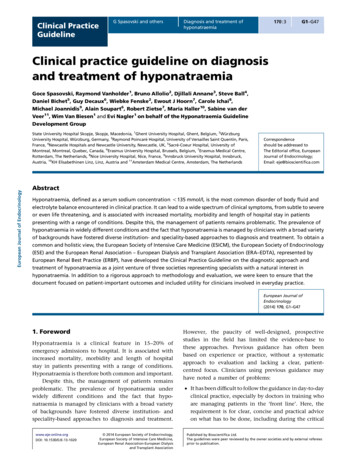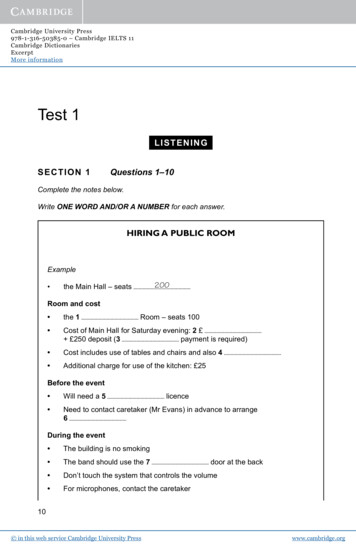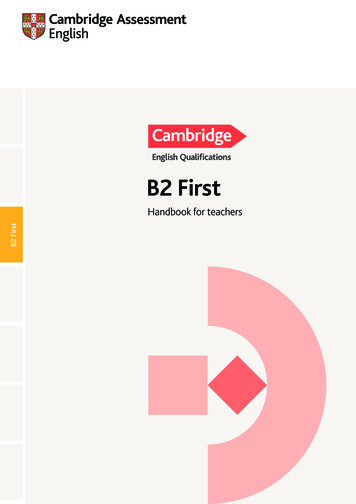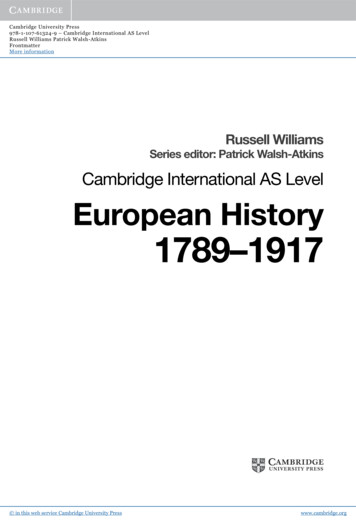
Transcription
Cambridge University Press978-1-107-61324-9 – Cambridge International AS LevelRussell Williams Patrick Walsh-AtkinsFrontmatterMore informationRussell WilliamsSeries editor: Patrick Walsh-AtkinsCambridge International AS LevelEuropean History1789–1917 in this web service Cambridge University Presswww.cambridge.org
ersity PressUniversity Printing House, Cambridge CB2 8BS, United KingdomCambridge University Press is part of the University of Cambridge.It furthers the University’s mission by disseminating knowledge in the pursuit ofeducation, learning and research at the highest international levels of excellence.www.cambridge.orgInformation on this title: www.cambridge.org/9781107613249 Cambridge University Press 2013This publication is in copyright. Subject to statutory exceptionand to the provisions of relevant collective licensing agreements,no reproduction of any part may take place without the writtenpermission of Cambridge University Press.First published 2013Printed in the United Kingdom by Latimer TrendA catalogue record for this publication is available from the British LibraryISBN 978-1-107-61324-9 PaperbackCambridge University Press has no responsibility for the persistence or accuracyof URLs for external or third-party internet websites referred to in this publication,and does not guarantee that any content on such websites is, or will remain,accurate or appropriate.www.cambridge.org
ersity PressContentsIntroduction41 The French Revolution and Napoleon 1789–1804The aims and domestic problems of French politicians 1789–91The instability of French governments 1791–99Napoleon Bonaparte’s rise to powerNapoleon’s domestic aims 1799–1804681930322 The Industrial Revolution c. 1800–50Causes of the Industrial Revolution by 1800What factors encouraged and discouraged industrialisation from1800 to 1850?The social effects of the Industrial Revolution on different classesThe political effects of the Industrial Revolution up to 185042443 Liberalism and nationalism: Italy and Germany 1848–71The rise of nationalism in Germany and ItalyPrussia and the unification of GermanyItalian leaders and the unification of Italy727481954857634 The origins of the First World WarThe development of the alliance systemMilitarism and the naval raceInstability in the BalkansReasons for the outbreak of war in 19141061081161231265 The Russian Revolution 1905–17www.cambridge.orgRussia at the beginning of the 20th centuryThe causes and immediate outcomes of the 1905 RevolutionThe strengths and weaknesses of Romanov rule 1906–14The causes of the February Revolution in 1917The Bolsheviks’ rise to power1361381411481521586 Examination skillsWhat skills will be tested in examination, and how?Knowledge and understanding questionsAnalysis and evaluation questionsSource-based questionsExamination s200
European History 1789–1917IntroductionCambridge International AS Level History is a new series of three booksthat offer complete and thorough coverage of Cambridge InternationalAS Level History (syllabus code 9389). Each book is aimed at one of theAS History syllabuses issued by Cambridge International Examinations forfirst examination in 2014. These books may also prove useful for studentsfollowing other A Level courses covering similar topics. Written in clearand accessible language, Cambridge International AS Level History – EuropeanHistory 1789–1917 enables students to gain the knowledge, understandingand skills to succeed in their AS Level course (and ultimately in furtherstudy and examination).Syllabus and examinationStudents wishing to take just the AS Level take two separate papers at theend of a one-year course. If they wish to take the full A Level there aretwo possible routes. The first is to take the two AS papers at the end of thefirst year and a further two A Level papers at the end of the following year.The second is to take the two AS papers as well as the two A Level papersat the end of a two-year course. For the full A Level, all four papers must betaken. The two AS papers are outlined below.ersity Presswww.cambridge.orgPaper 1 lasts for one hour and will be based on Liberalism and Nationalismin Italy and Germany 1848–71. The paper will contain at least three differentsources, and candidates will have to answer two questions on them. Studentsare not expected to have extensive historical knowledge to deal with thesequestions, but they are expected to be able to understand, evaluate and utilisethe sources in their answers, and to have sound background knowledgeof the period. In the first question (a) candidates are required to considerthe sources and answer a question on one aspect of them. In the secondquestion (b) candidates must use the sources and their own knowledge andunderstanding to address how far the sources support a given statement.Chapter 3 provides the appropriate level of historical knowledge to dealwith Paper 1.Paper 2 lasts for an hour and a half. The paper contains four questions,and candidates must answer two of them. Each question has two parts:part (a) requires a causal explanation; and part (b) requires consideration ofsignificance and weighing of the relative importance of factors. A questionon each of the four topics outlined in the Cambridge syllabus (for example,The Industrial Revolution c. 1800–50) will appear in every examination paper.4
ersity PressIntroductionExamination skillsChapter 6, which is entirely dedicated to helping students with examinationskills and techniques, gives guidance on answering all the different typesof exam questions. Students should read the relevant section of the examskills chapter before addressing practice questions, to remind themselvesof the principles of answering each type of question. Remember that factsalone are not enough; they must be accompanied by a clear understandingof the questions and must employ a range of skills such as focused writing,evaluation and analysis.All chapters have a similar structure. They key features are as follows:European History 1789–1917Chapter2The Industrial Revolutionc. 1800–50Key questionsContent summary Changes in pre-industrialpre-industrial society,society, including early mechanisation.roads and canals.Changes in communications, roadspower, railways and machines.Developments in steam power,Trade and the conservative interests.interests.Tradeupper,The social impact of the Industrial Revolution on the upper,middle and lower classes. Urbanisation and the impact of industrialisation on standardsof living. Changes and challenges to political systems.osperity and decline The rise of the middle classes, relative prosperityof industrialisation. What weree the causesof the IndustrialRevolution by 1800? What factorsencouraged anddiscouragedindustrialisation from1800 to 1850? How did the IndustrialRevolution affectdifferent classes upto 1850? What were thepolitical and economiceffects of theIndustrial Revolutionup to 1850?TimelineFeb 1804Sep 1825Jun 1832Jan 1834Dec 1835Aug 1837May 1838Feb 1848Mar 185142Richard Trevithick’s steam engine makes its firstjourney in BritainStockton to Darlington railway opens in BritainReform Act grants the vote to middle classes in BritainZollverein (customs union of 18 states) formed inGermanyFirst steam-operated railway opens in GermanyRailway from Paris to St Germain begins operationin FrancePeople’s Charter issued in Britain, demandingpolitical reformRevolution breakseaks out in France, stronglystrongly influenced byindustrialisation; Karl Marx publishes The CommunistManifestoCensus reveals more people in towns than countrysidein BritainEuropean History 1789–1917Key figureLazare NicolasMarguerite, CountCarnot (1753–1823)Count Carnot wasan engineer andmathematician beforemoving into politicsduring the FrenchRevolution. His idea ofintroducing conscriptionresulted in the Frencharmy increasing from650,000 soldiers to1.5 million in little morethan a year. Carnot alsoarranged for sufficientweapons and food forthis large force. Hebecame known as the‘Organiser of Victory’.Most French army offifficerscers had been dismissed or had fleded the country asroyalists, and this left the French forces weak and lacking in strong leadership.When Prussian troops crossed the border and began marching on Paris,it seemed that the revolution might be crushed at last and the monarchyLazare NicolasNicoNicolaslas Marguerite,MargMargueueriritete CountCounCountt Carnot,CarnCarnototrestored. On the advice of Lazarethe Jacobin government increased French forces through conscription, andthey won a surprising victory at the Battle of Valmy in September 1792.However, the danger to the revolution was not over, and there were fearsof treason when Charles-François du Périer Dumouriez, a leading general,deserted and joined the Austrians. Such events only served to further weakenthe government.The Girondins and the JacobinsThe two leading radical groups during the French Revolution were thehe southGirondins and the Jacobins. The Girondins were originally from theence theof France. They supported the rights of the provinces to influenceegardedrevolutionary movement and were therefore opposed by those who regardedParis as the centre of the revolution, including the sans-culottes. The Jacobinsformed in Paris, although Jacobin clubs were later organised in the provinces,oderate intoo. At the start of the revolution the Jacobins were relatively moderatetheir demands, but they soon became more extreme.Note:conscriptionCompulsory militaryservice for certaingroups of society,such as men betweenparticular ages.The JaJacobinscobins were named afteafafterterr the place they held their earlymeetingsmeetings – a convent in RuRuee St JacquesJacques in PaParis.ris. TheyThey were alsocalllledcaed the MontagnardsMontagnardss (‘Mountain People’),MontagnardPeoplePeople’)’),, becausebecausesometimes calledthey sat in the higherhigher levellevel of seatsseatseatss duringduring debatesdebatdebateses in the Assembly.AssemblyAssembly.theyIn France, the revolution benefited the middle class more than other groups.Members of this class gained from land transfers and from changes in trade.The Directory and Napoleon, as well as later governments, took pains towin the support of these people. Peasants were freed from feudal obligationsand Church taxes, but neither they nor the poor who lived in towns gainedpolitical power until the late 19th century.Questions1 What do you think were the three most significant turning points in thecourse of the French Revolution between 1789 and 1799? Give reasonsfor your choices.2 What had the revolution achieved by 1799?1 Key questions pose thought-provokingpointers to the key issues being dealt within the chapter.2 Content summary explains the essence ofa chapter.3 Timeline offers an overview of significantevents of the period.4 Key figures offer a detailed profile of keypersonalities.5 Notes highlight significant points fromwithin the text.www.cambridge.org6 Definitions of key terms enhance students’understanding of the text.7 Questions interspersed within the chaptershelp to consolidate learning.3 With reference to the historical debate on page 25, which view ofRobespierre do you find most convincing?203Liberalism and nationalism: ItalyItaly and GermanyGermany 1848–71Key issuesThe key features of this chapter are:8 Key issues outline the main aspects ofthe content that might be significant forexam preparation. The extent to which certain individuals rather than social conditionswere the real force behind the unification of Italy and Germany. The roles that liberalism and nationalism played in the unification ofthese two countries.9 Revision questions help studentsassess their own understanding and skills.ItalItalyy andand The similarities and differences in the process of unification in ItalyGermany.catitionon The importance of Piedmont and Prussia to Italian and German unificationrespectively.Revision questions1 Did the 1848 revolutions represent more a victory or a defeatdefeat forfornationalism in Germany and Italy?10 Further reading provides a list of extraresources that will help with gaining awider perspective of the topic.2 Describe the problems that the liberals in Germany faced between 1815and 1870.483 Why did Piedmont lead the movement for a united Italy from 1848to 1871?ng4 Why were monarchists more successful than the republicans in unifyingItaly by 1871?Further readingClark, M. The Italian Risorgimento. London, UK. Pearson. 1998.Collier, M. Italian Unification 1820–71. London, UK. Heinemann. 2003.07.07Farmer, A. The Unification of Germany 1815–1919. London, UK. Hodder. 2007.Gooch, J. The Unification of Italy. London, UK. Routledge. 1986.Pearce, R. and Stiles, A. The Unification of Italy. London, UK. Hodder. 2006.Whitfield, R. Germany 1848–1914. London, UK. Heinemann. 2000.Williamson, D. G. Bismarck and Germany 1862–1890. London, UK. Longman.1997.Advanced readingBeales, D. and Biagini, E. The Risorgimento and the Unification of Italy. London,UK. Longman, 2002.Hargreaves, D. Bismarck and German Unification. Basingstoke, UK. Macmillan,1991.1055
1 The French Revolution and Napoleon 1789-1804 6 The aims and domestic problems of French politicians 1789-91 8 The instability of French governments 1791-99 19 Napoleon Bonaparte's rise to power 30 Napoleon's domestic aims 1799-1804 32 2 The Industrial Revolution c. 1800-50 42 Causes of the Industrial Revolution by 1800 44


